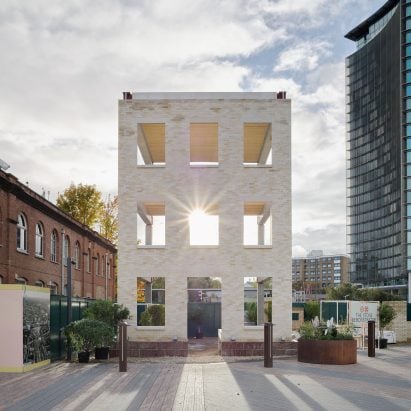
Design Museum pushes for stone construction in the UK with Stone Demonstrator
Stone forms the facade, frame, foundations, and floor slabs in the Stone Demonstrator—a ground-breaking project by London’s Design Museum aimed at encouraging the British construction industry to embrace this “ultra-low-carbon” material. While stone is a traditional structural material, it is often overlooked in contemporary construction. The Stone Demonstrator puts stone front and center, showcasing a full-scale prototype section of a small housing block at Empress Place within West London’s Earls Court development.
This innovative approach replaces all concrete, fired clay brick, and nearly all steel typically used in similar buildings, reducing carbon emissions by approximately 90%. The project is a collaboration between the Design Museum’s Future Observatory—a research initiative dedicated to driving the green transition—architects Groupwork, and engineers Webb Yates and Arup, all of whom have experience with structural stone.
Groupwork founder and chairman Amin Taha explained that the demonstrator’s aim is to show the local construction industry how simple it is to build with stone, using standard products and codes. “Its purpose is not to promote stone for sentimental reasons but as an ultra-low-carbon alternative to reinforced concrete and steel structures clad in fired clay bricks,” said Taha. “At 90% less embodied carbon and the same price as concrete and steel frames and fired clay bricks, it’s the ethical choice.”
The Stone Demonstrator utilizes stone throughout, beginning with the foundations. These were formed from reused stone blocks sourced from a decommissioned bank, installed in a way reminiscent of historic building footings. Above, a frame designed by Webb Yates and Arup uses a modern approach: stone blocks pre-tensioned into beams and columns, then positioned onsite. Steel tendons pass through cavities in the stone and are compressed with steel plates, creating secure structural elements that are also disassemblable and reusable in future projects.
While this type of frame exceeds the structural needs for a three-story building, both Taha and Webb Yates associate director Liam Bryant suggest it could replace concrete or steel frames in towers up to 80 stories.
For flooring, the Stone Demonstrator features two slab options. One mirrors the pre-tensioned stone approach used in the frame, but with a different form. The other introduces a hybrid timber and stone product—invented by Webb Yates and now produced by German manufacturer Bamberger. This method involves stone slabs fixed atop dowel-laminated timber (DLT), offering a sustainable replacement for traditional concrete slabs.
Justin McGuirk, director of Future Observatory, likens concrete to “the ultra-processed food of the construction industry”—a modern convenience that falls short compared to raw stone. Bryant elaborates: “Concrete is stone that you dug up, crushed, burned, mixed with other stone, dredged sand from probably under the sea, mixed with water, and chucked in the back of a lorry that has to spin at a regular rate. Stone construction is the same material. You dig it out of the ground, you cut it into pieces, you maybe put some rebar in it. It’s one-third of the process.”
In addition to replacing steel and concrete, the Stone Demonstrator challenges the use of fired clay bricks—a hallmark of London’s architectural vernacular—by deploying a self-supporting facade of bricks cut from raw stone. While clay bricks are seldom scrutinized for sustainability, stone bricks offer a 90% reduction in carbon emissions. This represents a significant opportunity, given the UK’s annual consumption of up to 2.5 billion bricks.
Calculations by the Stone Demonstrator team reveal the stark difference in emissions: an equivalent building with a steel frame and clay brick facade would emit around 40,000 kilograms of carbon dioxide, and one with a reinforced concrete frame would emit 32,000 kilograms. In comparison, the Stone Demonstrator emitted just 3,000 kilograms of carbon dioxide.
Dezeen featured an in-depth look at stone as a low-carbon, modern structural material in its Stone 2.0 series in 2024. Many experts supported the use of stone, but architect and researcher Natalia Petkova emphasized the importance of proper selection, sourcing, and transportation to maximize its sustainability.
Photography by Bas Princen.
—
*For more information on the Stone Demonstrator and sustainable building practices, visit the Design Museum’s Future Observatory and check out the Dezeen Stone 2.0 series.*
https://www.dezeen.com/2025/11/11/design-museum-stone-demonstrator-architecture/
You may also like
You may be interested
Globe bets on prepaid fiber, sets expansion
No content was provided to convert. Please provide the text...
Bragging rights up as Samal makes 5150 debut
A stellar Open division field will be shooting for the...
DigiPlus launches P1-M surety bond program
MANILA, Philippines — DigiPlus Interactive Corp. has partnered with Philippine...
 The New York Times
The New York Times
- Iraqis Are Voting for a New Parliament. Here’s What to Know. 2025 年 11 月 11 日 Erika Solomon and Falih Hassan
- Pakistan ‘in a State of War’ After Explosion Kills 12 in Capital 2025 年 11 月 11 日 Elian Peltier and Zia ur-Rehman
- Bookstore Food Drives Help Food Stamp Recipients 2025 年 11 月 11 日 Elizabeth A. Harris and Alexandra Alter
- Tatsuya Nakadai, Japanese Star Known for ‘Ran’ and Other Classics, Dies at 92 2025 年 11 月 11 日 Wendell Jamieson
- Senate Passes Bill to Reopen Government Amid Democratic Rift 2025 年 11 月 11 日 Catie Edmondson
- Judge Rejects Utah’s Republican-Drawn Redistricting Map 2025 年 11 月 11 日 Ali Watkins
- As Iraqis Vote for a Parliament, U.S. Presses to Rid Country of Iran’s Influence 2025 年 11 月 11 日 Erika Solomon
- For Trump, Nothing Was Off Limits During the Shutdown 2025 年 11 月 11 日 Luke Broadwater
- Sarah Jessica Parker Describes Her Year as a Booker Prize Judge 2025 年 11 月 11 日 Alex Marshall and OK McCausland
- Modi Vows Justice as Police Suspect Terrorism in Deadly New Delhi Blast 2025 年 11 月 11 日 Mujib Mashal



Leave a Reply